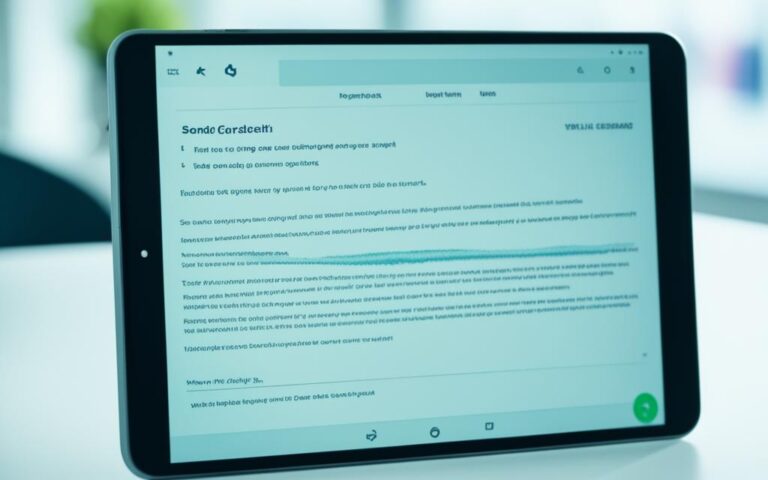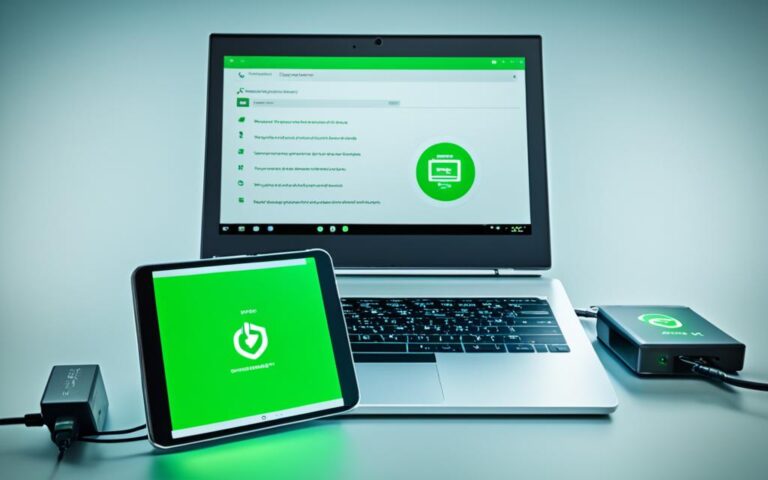How to Fix Tablet Kernel Panic Errors
Welcome to our troubleshooting guide for tablet kernel panic errors. If you are a tablet user in the UK and have encountered these frustrating errors, you’ve come to the right place. In this guide, we will provide you with the necessary steps to fix kernel panic errors and restore your tablet’s functionality.
Tablet kernel panic errors can occur even on stock devices and can be quite perplexing. However, with our detailed troubleshooting process, you’ll be able to identify the root causes of these errors and resolve them effectively.
Whether you’re experiencing hardware/software interaction issues or problems with your tablet’s RAM modules, understanding the causes of kernel panic errors is crucial. Our guide will walk you through the different factors that can lead to these errors, enabling you to tackle them head-on.
Through a systematic troubleshooting approach, you’ll be able to fix tablet kernel panic errors. From performing a factory reset to flashing TWRP recovery and checking for software updates, our guide provides step-by-step instructions to help you resolve these issues.
If you own a Macbook and are encountering tablet kernel panic errors, don’t worry, we have you covered. Our guide includes specific methods for fixing these errors on a Macbook, such as reinstalling Lion, resetting the SMC and NVRAM, and repairing the hard drive and permissions.
To prevent future tablet kernel panic errors, our guide also offers valuable tips on how to avoid them. Keeping your firmware up-to-date, disconnecting problematic devices, and avoiding energy-saving options are some of the recommended practices to maintain a stable and error-free tablet experience.
In addition, our guide explores common causes of tablet kernel panic errors, such as issues with RAM modules, corrupt NVRAM settings, and problematic external devices. By identifying these causes, you’ll be better equipped to find the appropriate solutions.
In conclusion, tablet kernel panic errors can be frustrating, but with the right troubleshooting steps, they can be resolved. Whether you’re a UK tablet user or facing these errors elsewhere, our guide provides a comprehensive and informative resource to help you fix kernel panic errors with confidence.
Understanding Tablet Kernel Panic Errors
Kernel panic errors are one of the most severe crashes that can occur on a tablet. These errors can be frustrating and disruptive, causing the device to freeze or restart unexpectedly. To effectively troubleshoot and fix these errors, it’s crucial to understand their causes.
Tablet kernel panic errors can be triggered by a variety of factors, including hardware and software interactions, as well as issues with the tablet’s RAM. When the hardware and software components of a tablet fail to communicate properly, it can result in a kernel panic. Additionally, problems with the tablet’s RAM modules, such as loose connections or faulty RAM, can also lead to kernel panics.
In some cases, kernel panic errors can be caused by the use of incompatible or malfunctioning external devices, such as a firewire hard drive with bad firmware. This further emphasizes the importance of hardware/software compatibility in maintaining stable tablet performance.
“Kernel panic errors on tablets can be caused by a variety of factors, including hardware/software interaction issues and problems with RAM modules.”
The Impact of Hardware/Software Interaction
Effective troubleshooting of tablet kernel panic errors requires a thorough understanding of the complex relationship between hardware and software. Tablets rely on a delicate balance between these two components to function properly. When this balance is disrupted, kernel panics may occur.
Hardware/software interaction issues can arise when there are compatibility issues between the tablet’s operating system and the installed applications. Outdated or incompatible software can generate conflicts that lead to kernel panics. Additionally, faulty drivers, firmware, or BIOS can also contribute to these errors.
Ultimately, identifying and addressing hardware/software interaction issues is crucial to resolving tablet kernel panic errors and restoring optimal performance.
RAM Issues and Kernel Panics
The tablet’s RAM plays a critical role in its overall performance. Problems with the RAM can lead to various issues, including kernel panics. Loose RAM modules or faulty RAM can cause the tablet to crash and display kernel panic errors.
It is essential to check the tablet’s RAM modules and ensure they are securely and correctly installed. Additionally, faulty RAM should be replaced to avoid further kernel panic issues.
To check the RAM on your tablet, follow these steps:
- Power off your tablet.
- Locate the RAM compartment (refer to your tablet’s user manual for guidance).
- Ensure the RAM modules are firmly seated in their slots.
- If necessary, carefully remove and reposition the RAM modules.
- Power on your tablet and observe for any improvements.
Tablet Kernel Panic Error Causes Table:
| Cause | Description |
|---|---|
| Hardware/Software Interaction Issues | Compatibility problems between the tablet’s operating system and applications, outdated or incompatible software, faulty drivers, firmware, or BIOS. |
| RAM Issues | Loose RAM modules or faulty RAM can cause the tablet to crash and display kernel panic errors. |
| Problematic External Devices | Use of incompatible or malfunctioning external devices (e.g., firewire hard drive with bad firmware) can trigger kernel panics. |
Understanding the causes of tablet kernel panic errors is essential for effective troubleshooting. By addressing hardware/software interaction issues, checking and replacing faulty RAM modules, and ensuring compatibility with external devices, users can resolve these errors and restore stable tablet performance.
Troubleshooting Tablet Kernel Panic Errors
If you’re experiencing tablet kernel panic errors on your device, don’t worry! There are several troubleshooting steps you can take to fix the issue and get your tablet back to normal functioning. Follow these steps to determine the cause of the errors and find a solution.
1. Perform a Factory Reset:
If your tablet is experiencing recurring kernel panic errors, a factory reset might help resolve the issue. Keep in mind that a factory reset will erase all your data, so make sure to back up important files before proceeding. To perform a factory reset, follow the device manufacturer’s instructions.
2. Flash TWRP Recovery:
If a factory reset doesn’t solve the kernel panic errors, you can try flashing TWRP recovery. TWRP (Team Win Recovery Project) is a custom recovery software that allows you to install custom ROMs, mods, and perform advanced troubleshooting tasks. Flashing TWRP recovery may help fix any underlying software issues causing the kernel panic errors.
3. Check for Software Updates:
Software updates often include bug fixes and improvements that can address kernel panic errors. Make sure to check for any available updates for your tablet’s operating system and applications. To check for updates, go to the device settings or app store and follow the instructions to install the latest software updates.
By following these troubleshooting steps, you can effectively address tablet kernel panic errors and restore your device’s stability. Remember to always backup your data before performing any major changes to your tablet’s settings or software.
Common Tablet Kernel Panic Error Solutions
| Issue | Solution |
|---|---|
| Recurring kernel panic errors | Perform a factory reset |
| Software issues causing kernel panic | Flash TWRP recovery |
| Bugs or compatibility issues | Check for software updates |
Remember to consult your device’s user manual or contact customer support for specific troubleshooting steps tailored to your tablet model.
Fixing Tablet Kernel Panic Errors on a Macbook
If you encounter tablet kernel panic errors on your Macbook, there are several methods you can try to fix the issue and restore your device to normal operation. Here are some troubleshooting steps:
- Reinstall Lion without erasing the drive: One option is to reinstall the Lion operating system without erasing the drive. This process can help resolve any issues with the system files that may be causing the kernel panic errors. A fresh installation of the operating system can often fix software-related problems.
- Repair the hard drive and permissions: Sometimes, kernel panic errors can be caused by disk errors or incorrect permissions on system files. You can use the Disk Utility tool to repair the hard drive and fix any permissions issues. This process can help address underlying problems that may be triggering the kernel panic errors.
- Reset the System Management Controller (SMC) and Non-Volatile Random Access Memory (NVRAM): Resetting the SMC and NVRAM can help resolve various hardware-related issues, including kernel panic errors. The SMC manages various aspects of your Macbook’s hardware, while the NVRAM stores important settings. By resetting these components, you can potentially fix any problems that are causing the kernel panic errors.
By following these troubleshooting steps, you can increase the chances of resolving tablet kernel panic errors on your Macbook. Remember to back up your important files before attempting any system changes to prevent potential data loss.
Keep in mind that if the kernel panic errors persist despite your efforts, it may be necessary to reach out to a professional technician or contact Apple support for further assistance.
Common Causes of Tablet Kernel Panic Errors
When experiencing tablet kernel panic errors, it is essential to identify the underlying causes in order to effectively resolve the issue. Common causes of these errors include:
- Bad Memory: Problems with RAM modules can trigger kernel panic errors. Faulty or incompatible memory modules can lead to system instability and crashes.
- Bad NVRAM: Corrupt or problematic NVRAM (Non-Volatile Random Access Memory) settings can also contribute to tablet kernel panic errors. Issues with NVRAM, which stores important system configurations, can disrupt the device’s normal operation.
- Bad Devices: External devices such as FireWire or USB devices can introduce compatibility conflicts or faulty drivers, resulting in kernel panic errors. It is crucial to ensure that all connected devices are functioning properly and have up-to-date drivers.
By identifying these common causes, users can take appropriate steps to tackle tablet kernel panic errors. Let’s explore some targeted solutions in the upcoming sections.
“Understanding the causes of tablet kernel panic errors is crucial for effective troubleshooting and resolution.”
Avoiding Tablet Kernel Panic Errors
To avoid tablet kernel panic errors, it is crucial to take proactive measures and ensure that your device is optimized for stability. By following a few simple guidelines, you can significantly minimize the risk of encountering these frustrating issues.
Keep Firmware Up-to-Date
One of the key steps in preventing tablet kernel panic errors is to regularly update your device’s firmware. Manufacturers release firmware updates to address known bugs and vulnerabilities, improving system stability and performance. By installing the latest firmware version, you can ensure that your tablet is equipped with the most reliable software.
Disconnect Devices and Test Compatibility
When encountering kernel panic errors, it can often be helpful to disconnect any external devices connected to your tablet. This includes accessories such as keyboards, mice, or external storage. By disconnecting and reconnecting devices one by one, you can identify if any particular device is causing compatibility issues that may lead to kernel panic errors.
Avoid Energy Saving Options
While energy-saving options can be beneficial for extending battery life, they may sometimes contribute to kernel panic errors. To minimize the risk, consider disabling or adjusting these power-saving features, such as screen dimming, sleep mode, or automatic shutdown. By maintaining a stable power supply and avoiding aggressive energy-saving settings, you can reduce the likelihood of kernel panic errors.
Tips for Avoiding Tablet Kernel Panic Errors
| Tips | Description |
|---|---|
| Keep Firmware Up-to-Date | Regularly update your tablet’s firmware to enhance stability and address known issues. |
| Disconnect Devices and Test Compatibility | Disconnect external devices one by one to identify any compatibility issues that may cause kernel panic errors. |
| Avoid Energy Saving Options | Disable or adjust energy-saving features to maintain a stable power supply and minimize the risk of kernel panic errors. |
By following these preventive measures, you can create a more stable and reliable environment for your tablet, reducing the chances of encountering kernel panic errors. Remember to stay informed about the latest firmware updates and regularly check for compatibility issues with external devices to ensure optimal performance.
Resolving Tablet Kernel Panic Errors through Settings
When tablet kernel panic errors occur, it can often be attributed to incorrect or corrupt settings. Fortunately, there are several steps you can take to resolve these issues and restore your tablet’s normal functionality.
Resetting Energy Saving Options
One of the potential culprits behind kernel panic errors is the energy saving options on your tablet. It’s worth resetting these settings to their default values to see if it resolves the issue. To do this, go to the settings menu, locate the energy saving options, and choose the reset or restore default settings.
Clearing NVRAM and PRAM
Another troubleshooting step to consider is clearing the non-volatile random-access memory (NVRAM) and parameter random-access memory (PRAM) on your tablet. These settings store certain system configurations and can sometimes become corrupted, leading to kernel panic errors. Clearing them can help resolve the issue. To do this, follow the instructions specific to your tablet model.
For example, on an iPad, you can clear the NVRAM and PRAM by turning off the device, then holding down the power button and the Home button simultaneously until the Apple logo appears. Release the buttons and allow the tablet to restart. This should clear the NVRAM and PRAM settings.
Creating a New User Account
In some cases, creating a new user account on your tablet can help resolve kernel panic errors. This is because a corrupt user account can sometimes cause system instability. By creating a new user account and using it instead of the previous one, you can determine if the issue is specific to your user account. To create a new user account, go to the settings menu and look for the user accounts or accounts section. Follow the prompts to create a new account and then test the device with the new account.
By following these steps and taking the appropriate action, you can effectively resolve tablet kernel panic errors caused by settings. Remember to identify which settings might be causing the issue and target those specific settings for resolution.
| Steps to Resolve Tablet Kernel Panic Errors through Settings | Details |
|---|---|
| Resetting Energy Saving Options | Access the settings menu, locate energy saving options, and choose reset or restore default settings. |
| Clearing NVRAM and PRAM | Follow specific instructions for your tablet model to clear NVRAM and PRAM settings. |
| Creating a New User Account | Access the settings menu, look for user accounts or accounts section, and follow prompts to create a new account. |
Conclusion
Tablet kernel panic errors can be frustrating, but there is hope for resolving them. By understanding the causes and following the appropriate troubleshooting methods, users can effectively fix these errors and restore their tablets to normal functionality.
In this troubleshooting guide, we have explored the common causes of tablet kernel panic errors and provided step-by-step solutions to address them. Whether it’s performing a factory reset, flashing TWRP recovery, or updating the software, each method plays a crucial role in resolving these errors.
Furthermore, it is essential to avoid common pitfalls that can lead to tablet kernel panic errors. By keeping firmware up-to-date, disconnecting incompatible devices, and avoiding energy-saving options, users can prevent these errors from occurring in the first place.
With this comprehensive troubleshooting guide and a little bit of technical know-how, UK users can confidently tackle tablet kernel panic errors and have their devices running smoothly once again.











